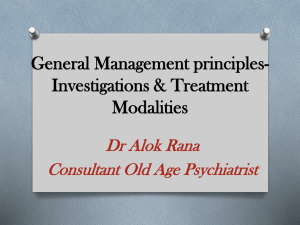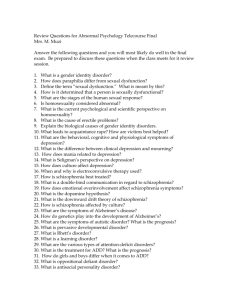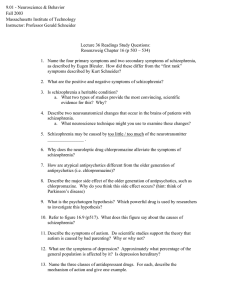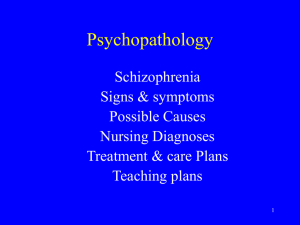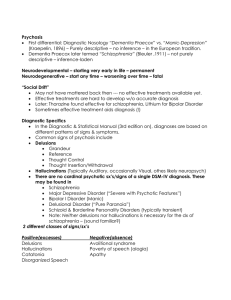Uploaded by
aqua-exodus
Psychiatry Exam Questions: Schizophrenia, Delusions, Hallucinations
advertisement
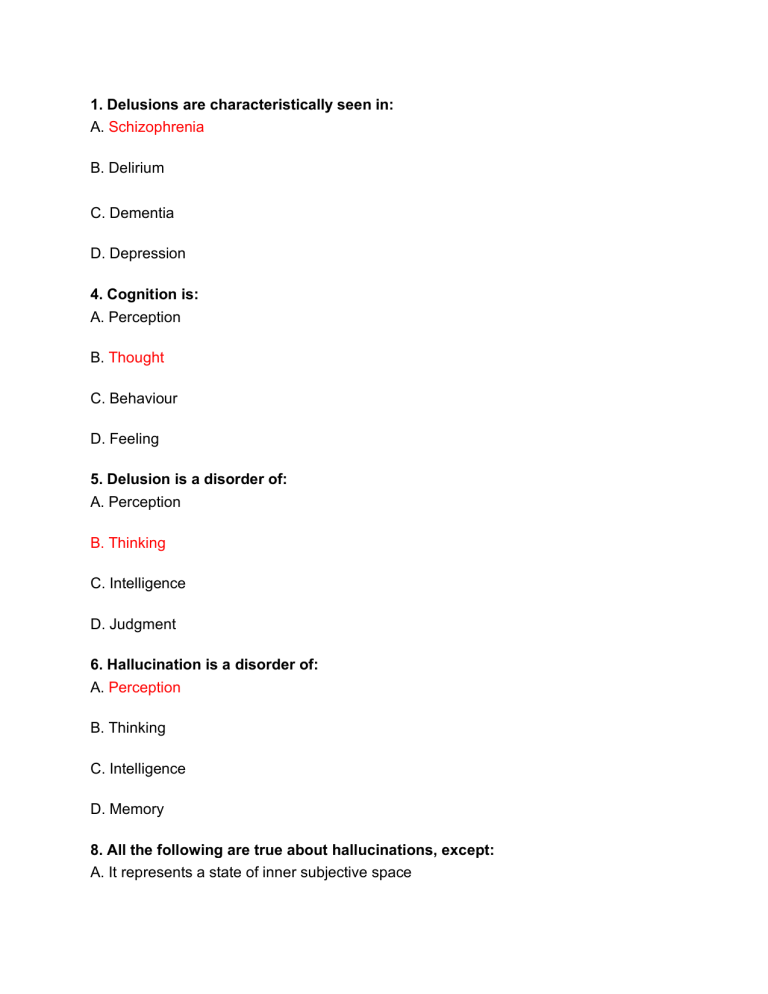
1. Delusions are characteristically seen in: A. Schizophrenia B. Delirium C. Dementia D. Depression 4. Cognition is: A. Perception B. Thought C. Behaviour D. Feeling 5. Delusion is a disorder of: A. Perception B. Thinking C. Intelligence D. Judgment 6. Hallucination is a disorder of: A. Perception B. Thinking C. Intelligence D. Memory 8. All the following are true about hallucinations, except: A. It represents a state of inner subjective space B. It is dependent of the observer C. It is as vivid as sensory perception D. It occurs in the absence of perceptional stimulus 10. 25-years house wife come to the psychiatry outpatients department complaining that her nose was longer than usual. She felt that her husband did not like her because of the deformity and had developed relationship with the neighboring girl. Further she complained that people made fun of her. It was not possible to convince her that there was no deformity. Her symptoms include: A. Delusion B. Depersonalization C. Depression D. Hallucination 11. Neologism is: A. Minting of words B. Totally C. Has some meaning D. Modification of word 12. Delusion is a false belief which is: A. Reasonable B. Comprehensible C. Both of the above D. None of the above 13. Auditory hallucinations are seen in all of the following except: A. Hysteria B. Mania C. Amphetamine toxicity D. Schizophrenia 15. Pseudo-hallucinations are not said symptoms of: A. Hysteria B. Schizophrenia C. Pseudo-neurotic schizophrenia D. Malingering 16. Delusion is seen in all, except: A. Mania B. Depression C. Anxiety neurosis D. Schizophrenia 18. Delusion is: A. A feeling of loss of sensation B. Not able to get proper answer C. A false belief D. An uncomfortable sensation. 19. Thought disorder is seen in: A. Obsessive-compulsive disorder B. Anxiety neurosis C. Schizophrenia D. Psychopathic personality 21. One of the following is a disorder of thought: A. Illusion B. Hallucination C. Delirium D. Delusion 25. Visual hallucinations are seen in: A. Alcoholism B. Mania C. Depression D. Phobia 28. ‘Mirage’ is an example of: A. Illusion B. Delusion C. Hallucination D. Extrasensory perception E. Fantasy 29. Delusion is not seen in: A. Anxiety B. Mania C. Depression D. Schizophrenia 31. Delusions of influence are characteristic of: A. Obsessive state B. Schizophrenia C. Depression D. Dramatization 32. Delusions and hallucinations are known as: A. Psychotic symptoms B. Neurotic symptoms C. Behavioral symptoms D. Psychosomatic symptoms Term psychosis is defined as Gross impairment of reality testing Loss of weight Pressure of characteristic symptoms like delusions and hallucination. 33. The commonest disorder of perception is: A. Delusion B. Hallucination C. Passivity D. Compulsion 36. A false sensory perception in the absence of external stimulus is: A. Hallucination B. Illusion C. Delusion D. Depersonalization 41. Confabulation is a defect of: A. Memory B. Intelligence C. Affection D. Concentration 44. Nihilistic delusion is seen in: A. Depression B. Schizophrenia C. Mania D. OCN 45. Neologism is characteristic of: A. Mania B. Schizophrenia C. Depression D. OCN 46. An 18-year-old hears voices discussing him in the third person. He has A. TLE B. Depression C. Mania D. Schizophrenia 50. Psychosis is characterized by all, except: A. Contact with reality is maintained B. Positive symptoms are usually present C. Impaired judgment D. Insight is lost. 52. A 23-year-old man has a fight with a boy in his neighborhood. The next day he feels two policemen are following him to arrest him. He is agitated and pales up and down him room. He feels that his neighbors are controlling his mind by sending waves from an electric device. He is suffering from: A. Delusions of persecution B. Though insertion C. Passivity D. Depression 9. A16-year-old boy does not attend school because of the fear of being harmed by school mats. He thinks that his class mates laugh at and take about him. He is even scared of going out to the market. He is most likely suffering from: A. Anxiety neurosis B. Manic-depressive psychosis C. Adjustment Reaction D. Schizophrenia 10. The most frequent period for onset of schizophrenia: A. Childhood B. Adolescence C. Middle adulthood D. Old age 11. The major neurotransmitter hypothesis states that there is a hyperactivity of dopaminergic systems in: A. Hysteria B. Anxiety enuresis C. Schizophrenia D. Obsession . 12. Auditory (third person) hallucinations, features of affect, disturbance, delusional perception, perplexity are seen in: A. Anxiety neurosis B. Hysteria C. Depression D. Schizophrenia 18. Paranoid schizophrenia present with: A. Abnormal behaviors B. Persecutory or grandiose delusions C. Psychomotor disturbance D. Incoherence and incongruous affect 20. Psychomotor features are seen in the following type of schizophrenia: A. Paranoid B. Residual C. Catatonic D. Hebephrenic 21. Percentage of schizophrenia affected patients in a population is (life time risk of schizophrenia): A. 1 percent B. 2 percent C. 0.5 percent D. 5 percent 22. Percentage of monozygotic twins with schizophrenia: A. 0.1 percent B. 1 percent C. 10 percent D. Over 50 percent 23. Bad prognosis in schizophrenia is associated with the following factors: A. Catatonia B. Gradual onset C. Presence of Depression D. Absence of family history 24. Which of the following is not a feature of schizophrenia? A. Literally means “Splitting of mind” B. Peak incidence occurs is 15 to 30 years age group C. People with low intelligence are more predisposed D. Predominantly a disease of females 25. All are features of schizophrenia except: A. Altered affect B. Incongruity of emotion C. Altered intellectual functions D. Neologisms 28. The most common type of hallucinations seen in schizophrenia is: A. Tactile B. Auditory C. Visual D. Olfactory 31. Negative symptoms of schizophrenia include all of the following, except: A. Affective blunting and flattening B. Hallucination C. Anhedonia D. Poverty of thought content 32. One of these symptoms does not occur in schizophrenia: A. Thought alienation B. Paranoid delusion C. Disorientation D. Hallucination 34. Best prognosis is seen with which symptom of schizophrenia: A. Apathy B. Anhedonia C. Auditory hallucination D. Poverty of thought 38. A bad prognostic factors in schizophrenia is: A. Late onset B. Family history of schizophrenia C. Affective symptoms D. Presence of depression 40. All the following are features of schizophrenia, except: A. Hallucination B. Elated mood C. Autochthonous derision D. Anhedonia 41. A 65-year-old man feels there are some people living upstairs who are going to take all his wealth and are always criticizing him, while his attendant states that there is no one living upstairs. The attendant also complains of the man’s weird behavior like keeping his shoes in the fridge, had wearing his vest over his shirt. The most likely diagnosis is: A. Delusion B. Schizophrenia C. Depression D. Hallucination 43. Kalloo, a 24-year-old occasional alcoholic shows a change in behaviors. He suspects that people are conspiring in behaviors; he suspects that people are aspiring against him though his father states that there is no reason for his fears. He also gets hallucinations of voice commenting on his actions. What is the most probable diagnosis? A. Delirium tremens B. Alcohol-induced psychosis C. Schizophrenia D. Delusional disorder 44. A schizophrenic patient is on antipsychotic, after a few days, he is not sleeping, not eating properly, not taking any interest in his surroundings. This indicates the possibility of all of the following except: A. Emergence of negative symptoms B. Major depression C. Parkinsonian features D. Reacting to demands of external environment 45. Lalloo, a 40-year-old, has recently started writing book. The matter in his book cannot be understood by anybody since it contains words which are not there in any dictionary and the theme is very disjointed, Nowadays he has become very shy and self-absorbed when he addresses people he speaks about metaphysical ideas what is the weekly diagnosis: A. Mania B. Schizophrenia C. A genius writer D. Delusional disorder 46. Kalloo, a 25 -year-old male living alone, starts suspecting that his neighbors are conspiring, against him. He lodges a complaint against them in the police station, which he is unable to prove. He also has auditory hallucinations. The symptoms have been present for the past 2 years. The diagnosis is: A. Schizophrenia B. Depression C. Mania D. Acute psychosis 47. 76-year-old TM Naidu presents with persecutory delusions third person hallucinations and disorganized behaviour since one month. His tendon reflexes are brisk and pupils normal, while his mini mental score is 20/30 and his memory is impressed. The diagnosis is: A. Dementia B. Schizophrenia C. Transient global amnesia D. MDP 49. A person for the past 10 months has not been taking care of himself, laughs by himself, and talks about spiritualistic ideas alone in the room. The most likely diagnosis is: A. Schizophrenia B. Highly spiritualistic person C. Mania D. Psychosis 1. Which of the following is not seen in mania? A. Delusion of grandeur : B. Elation C. Pressure of speech D. Disorientation 2. The commonest psychiatric disorder is: A. Dementia B Schizophrenia C. Paranoia D. Depression 3. Endogenous depression is characterized by all of the following, except: A. Paranoid feeling B. Third person hallucination C. Guilt psychosis D. Loss of self-esteem 4. The neurotransmitters involved in depression are: A. GABA and dopamine B. Serotonin and norepinephrine C. Dopamine and serotonin D. GABA and norepinephrine 6. Delusions of nihilism and early morning insomnia are seen in: A. Major depression B. Schizophrenia C. Mania D. Personality disorder 7. The most common age group for depression is: A. Middle-aged men B. Middle-aged females C. Young girls D. Children 8. A period of normalcy is seen between two psychotic episodes in: A. Schizophrenia B. Manic depressive psychosis C. Alcoholism D. Depression 9. A 20-year-old man has presented with increase alcohol consumption and sexual indulgence, irritability, lack of sleep, and not feeling fatigued even in prolonged periods of activity. All these changes are present for past 3 weeks. The most likely diagnosis is: A. Alcohol dependence B. Schizophrenia C. Mania D. impulse control disorder . 10. Ms. B, a 27-year-old nurse had extracurricular interest in trekking and painting. She broke up relationship with her boy friend. Two months later she lost interest in her hobbies and was convinced that she would not be able to work pain. She thought life was not worth living and has consumed 60 tablets of phenobarbitone to end her life. She is most likely suffering from: A. Adjustment disorder B. Conversion disorder C. Depressive disorder D. Post-traumatic stress disorder 11. Major depression is most commonly associated with: A. Poverty B. Major accident C. Prolonged physical illness D. Death of loved person 12. A person initially presenting with an episode of mania is classified as: A. Unipolar B. Bipolar C. Affective disorder D. Personality disorder 13. Mania is a: A. Obsessive disorder B. Mood disorder C. Neurotic disorder D. Psychological disorder 14. Mania is associated with the following, except: A. Euphoria B. Good humour C. Physical overactivity D. Thought disorders 15. Which of the following is not seen in mania? A. Delusions of grandeur B. Elation C. Pressure of speech D. Disorientation Note:-Disorientation occurs in delirium. 16. Atypical depression is characterized by all of the following, except: A. Increased libido B. Weight gain C. Ravenous appetite D. Hypersonic Weight gain, appetite. 17. Dysthymia is: A. Chronic mild depression B. Personality disorder C. Bipolar depression D. Chronic severe depression 18. Depression is a. an: A. Affective disorder B. Organic disorder C. Mood disorder D. Dissociate disorder 19. Profound mood disturbance is seen with: A. Schizophrenia B. Psychosomatic illness C. Depression and mania D. Affective disorders 20. Somatic symptoms of depression include all, except: A. Feelings of guilt B. Reduced interest C. Insomnia D. Weight change 22. Depression is not caused by: A. Metronome B. Methyldopa C. Reserpine D. Oral contraceptives 23. The following are feelings of cyclothymic personality except: A. Mood swings B. Excessive planning C. Spending sprees D. Mood incongruent delusions Note= mood swings seen in “Baby blues” 26. Acute mania with mood disturbance is: A. Feature of the following B. Borderline disorder C. Cyclothymiacs disorder D. Paranoid disorder. 29. Features of depression include all, except: A. Depressed mood B. Loss of appetite C. Hyperactivity D. Suicidal ideas 33. The family members of a 56-year-old man reports that he has become increasingly irritable, sleepless, has started spending large amounts of money, and shows increased sexual behavior. The most probable cause could be: A. Mania B. Psychosexual developmental disorder C. Impulse control disorder D. Obsessive-compulsive neurosis 35. A 55-year-old lady presented with decreased sleep and appetite and thoughts of spiritualism. She donates money and property and talks about God. Her husband died few days back and she has increased psychomotor activity. She is most likely suffering from: A. PTSD B. Mania episodes C. Brief reaction D. Depression 36. The most common cause of mood congruent delusion is: A. Obsessive-compulsive neurosis B. Schizophrenia C. Dementia D. Mania
